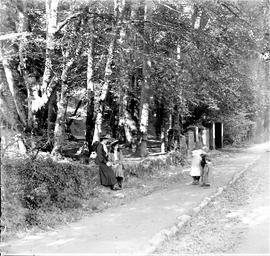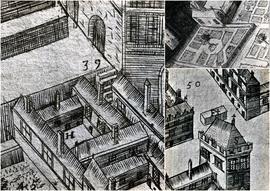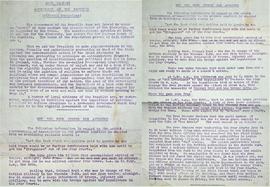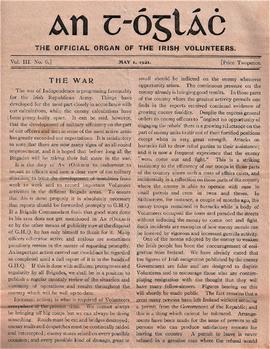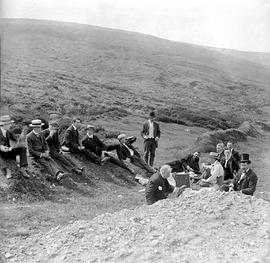'An Claidheamh Soluis' (‘the sword of light’) was an Irish nationalist newspaper published by Conradh na Gaeilge (the Gaelic League). It was published as a weekly bi-lingual newspaper for the advancement of the Irish language. Eoin MacNeill was its first editor. He oversaw its publication from 1899 to 1901. In 1900 the League took control of the weekly bilingual paper 'Fáinne an Lae' (See CA/IR/1/8/1/1). This title was merged with 'An Claidheamh Soluis' and the newspapers appeared as 'An Claidheamh Soluis agus Fáinne an Lae'. The paper was later published under the names of 'Fáinne an Lae' (1918–9; 1922–30) and 'Misneach' (1919–22).
The file contains the following issues of the newspaper under its various titles:
'An Claidheamh Soluis'
31 Jan. 1914-29 Dec. 1917
31 Jan. 1914 (pp 3-10 only)
13 Nov. 1915 (no. 920)
1 Mar. 1916 (no. 937)
29 Apr., 6, 13, 20, 27 May 1916 (no. 944)
10 May 1916 (no. 946)
24 May 1916 (no. 948)
9 Sept. 1916 (no. 959)
16 Sept. 1916 (no. 960)
23 Sep. 1916 (no. 961)
16 Dec. 1916 (no. 973)
21 July 1917 (no. 1,004)
4 Aug. 1917 (no. 1,006)
29 Sept. 1917 (no. 1,013)
20 Oct. 1917 (no. 1,017)
27 Oct. 1917 (no. 1,018)
3 Nov. 1917 (no. 1,019)
17 Oct. 1917 (no. 1,021)
24 Oct. 1917 (no. 1,022)
15 Dec. 1917 (no. 1,025)
22 Dec. 1917 (no. 1,026)
29 Dec. 1917 (no. 1,029)
'Fáinne an Lae'
9 Mar. 1918-20 Sept. 1919
9 Mar. 1918 (no. 1037)
13 Apr. 1918 (no. 1,042) – 4 May 1918 (no. 1,045)
18 May 1918 (no. 1,047) – 25 May 1918 (no. 1,048)
15 June 1918 (no. 1,051)
4 Jan. 1919 (no. 1,080)
23 Aug. 1919 (no. 1,113)
20 Sept. 1919 (no. 1,117)
'Misneach'
7 Feb. 1920-4 Dec. 1920
7 Feb. 1920 (no. 12)
29 May 1920 (no. 28)
26 June 1920. (one sheet only)
3 July 1920 (no. 33)
10 July 1920 (no. 34)
17 July 1920 (no. 35)
31 July 1920 (no. 37). Oireachtas 1920 edition.
11 Sept. 1920 (no. 43)-2 Oct. 1920 (no. 46)
16 Oct. 1920 (no. 48)-4 Dec. 1920 (no.

